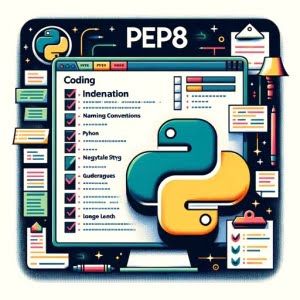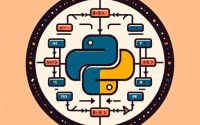PEP8 Python Style Guide

Ever found yourself puzzled over Python’s PEP8 style guide? You’re not alone. Many developers find themselves in a maze when it comes to understanding and implementing PEP8.
Think of PEP8 as a grammar book for Python – it’s designed to help you write clean, readable code that’s consistent across the Python community.
In this guide, we’ll walk you through the process of mastering PEP8 in Python, from the basics to more advanced techniques. We’ll cover everything from indentation, line length, whitespace, naming conventions, to using linters or formatters that enforce PEP8 rules, and even alternative style guides.
So, let’s dive in and start mastering PEP8 in Python!
TL;DR: What is PEP8 in Python?
PEP8 is Python’s official style guide that recommends coding standards for Python code. It covers topics like indentation, variable naming, line length, and more. It’s like a grammar book for Python, helping you write clean, readable, and consistent code.
Here’s a simple example:
# PEP8 compliant code
def function_name(argument_one, argument_two):
# This is a PEP8 compliant comment
return argument_one + argument_two
print(function_name(5, 10))
# Output:
# 15
In this example, we’ve written a simple function following PEP8 guidelines. The function name and arguments are in lowercase with words separated by underscores (snake case), there’s a space after the # in the comment, and operators are surrounded by spaces.
This is just the tip of the iceberg when it comes to PEP8 in Python. Continue reading for a more detailed understanding and advanced usage scenarios.
Table of Contents
- PEP8 Basics: Indentation, Line Length, Whitespace, and Naming Conventions
- PEP8 Enforcement: Linters and Formatters
- Exploring Alternatives: Google’s Python Style Guide
- PEP8 Troubleshooting: Common Issues and Solutions
- The Philosophy Behind PEP8
- PEP8 in the Larger Context of Python Programming
- Wrapping Up: Mastering PEP8 in Python
PEP8 Basics: Indentation, Line Length, Whitespace, and Naming Conventions
PEP8 covers several basic rules that every Python developer should know. Let’s break down these rules and see how they make Python code more readable and consistent.
Indentation
In Python, indentation isn’t just for readability. It’s a language feature. PEP8 recommends using 4 spaces per indentation level. Here’s an example:
# PEP8 compliant indentation
def add_numbers(num1, num2):
result = num1 + num2
return result
print(add_numbers(5, 10))
# Output:
# 15
In the example, we’ve used 4 spaces to indent the lines within the function.
Line Length
PEP8 suggests a maximum line length of 79 characters. This recommendation is based on the fact that having shorter lines improves readability.
Whitespace
PEP8 recommends using whitespace in certain situations, such as around operators and after commas to improve readability. Here’s an example:
# PEP8 compliant whitespace usage
my_list = [1, 2, 3, 4, 5]
for i in my_list:
print(i * 2)
# Output:
# 2
# 4
# 6
# 8
# 10
In the example, we’ve used a space after each comma in the list and around the multiplication operator.
Naming Conventions
PEP8 provides several naming conventions. For example, function names, variable names, and method names should be in lowercase with words separated by underscores (snake case). Constants should be in all uppercase with words separated by underscores.
# PEP8 compliant naming conventions
CONSTANT = 'I am a constant'
def this_is_a_function():
variable = 'I am a variable'
return variable
print(this_is_a_function())
# Output:
# 'I am a variable'
In the example, we’ve followed PEP8 naming conventions for the function, variable, and constant.
By following these basic PEP8 rules, you can write cleaner, more readable Python code that’s consistent with the broader Python community.
PEP8 Enforcement: Linters and Formatters
As you become more comfortable with PEP8, it’s time to explore tools that can help enforce PEP8 rules in your code. Two popular tools in the Python community are pylint and autopep8. These tools help you identify PEP8 violations and, in some cases, automatically fix them.
Pylint: Your PEP8 Watchdog
Pylint is a highly customizable source-code, bug and quality checker for Python. It ensures your code follows PEP8 guidelines and even checks for errors and potential refactoring places.
To use pylint, you first need to install it using pip:
pip install pylint
Then, you can run pylint on your Python script:
pylint my_script.py
Pylint will output a detailed report of any PEP8 violations in your script.
Autopep8: Automatic PEP8 Formatter
While Pylint points out PEP8 violations, autopep8 goes a step further and automatically formats your code to comply with PEP8. This can be a significant time-saver, especially for larger codebases.
To install autopep8, use pip:
pip install autopep8
You can then run autopep8 on your Python script:
autopep8 --in-place --aggressive --aggressive my_script.py
The --in-place option makes changes to the file directly, and the --aggressive option enables non-whitespace changes.
By leveraging tools like pylint and autopep8, you can ensure your Python code adheres to PEP8 guidelines, enhancing its readability and maintainability.
Exploring Alternatives: Google’s Python Style Guide
While PEP8 is the official style guide for Python, it’s not the only one. Many organizations, including Google, have their own Python style guides that slightly differ from PEP8. It’s essential to understand these differences, especially if you’re planning to contribute to projects that follow these alternative style guides.
Google’s Python Style Guide is one such example. It agrees with PEP8 on many points but differs in some areas. For instance, Google’s guide recommends a maximum line length of 80 characters (compared to PEP8’s 79), and it prefers using single quotes for strings unless a string contains a single quote character.
To illustrate these differences, let’s look at a comparison table:
| — | PEP8 | Google’s Python Style Guide |
|---|---|---|
| Maximum Line Length | 79 characters | 80 characters |
| String Quotes | No preference | Prefer single quotes |
Here’s an example of code that follows Google’s Python Style Guide:
# Google's Python Style Guide compliant code
def 'add_numbers'(num1, num2):
'result' = num1 + num2
return 'result'
print('add_numbers'(5, 10))
# Output:
# 15
In this example, the function name and variable are enclosed in single quotes, and the line length doesn’t exceed 80 characters.
Understanding alternative style guides like Google’s can broaden your perspective and make you a more versatile Python programmer.
PEP8 Troubleshooting: Common Issues and Solutions
While PEP8 provides a solid foundation for writing readable and consistent Python code, it’s not uncommon to encounter challenges when trying to adhere to its guidelines. Let’s discuss some common issues developers face and how to solve them.
Overcoming Line Length Limitations
One of the common issues is dealing with the line length limit of 79 characters. This can be particularly challenging when you have long expressions or statements. A recommended way to overcome this is by using parentheses or backslashes to break up the lines.
# Breaking up long lines
long_string = ('This is a very long string that is definitely '
'more than seventy-nine characters long.')
print(long_string)
# Output:
# 'This is a very long string that is definitely more than seventy-nine characters long.'
In the above example, we’ve used parentheses and a backslash to break up a long string over multiple lines, ensuring we don’t exceed the PEP8 line length limit.
Dealing with Indentation Conflicts
Another common issue is conflicts between PEP8’s indentation rules and other formatting tools or editors. It’s essential to configure your development environment to use 4 spaces for indentation to avoid this issue.
Naming Conventions
Adhering to PEP8’s naming conventions can also pose challenges, especially if you’re used to a different naming style. It’s crucial to embrace PEP8’s snake_case for function and variable names, and ALL_CAPS for constants, to ensure consistency with the Python community.
By understanding these common issues and their solutions, you can more effectively adhere to PEP8 and write clean, readable Python code.
The Philosophy Behind PEP8
PEP8 isn’t just a set of arbitrary rules; it’s based on a philosophy of readability and consistency in Python programming. Python’s overarching philosophy, expressed in the Zen of Python, emphasizes the importance of code readability and simplicity. PEP8 is a concrete expression of this philosophy.
Why PEP8 Matters
PEP8 is important for several reasons. First, it promotes code readability. Python is renowned for its clean, readable syntax, and PEP8 guidelines further enhance this readability. When code is easy to read, it’s easier to understand, debug, and maintain.
Second, PEP8 ensures consistency. When all Python developers follow the same style guide, it creates a level of consistency that makes it easier to read and understand each other’s code. This is particularly important in open source projects where developers from around the world contribute code.
Third, PEP8 helps avoid common coding pitfalls. Many of its guidelines, such as using 4 spaces for indentation and limiting line length, help avoid bugs and make the code easier to navigate.
Here’s an example of PEP8 in action:
# PEP8 compliant code
def add_numbers(num1, num2):
result = num1 + num2
return result
print(add_numbers(5, 10))
# Output:
# 15
In this example, the function is clearly defined, the variables are well-named, and the code is easy to read. This is the power of PEP8.
Understanding the rationale behind PEP8 can help you appreciate its value and motivate you to follow its guidelines in your Python programming.
PEP8 in the Larger Context of Python Programming
PEP8 doesn’t exist in a vacuum. It plays a vital role in larger projects and relates to other aspects of Python programming, such as code review and continuous integration.
PEP8 and Code Review
In code review, other developers examine your code to catch bugs, check for consistent style, and ensure the code fits into the larger project. PEP8 provides a common standard that all developers can follow, making this process smoother and more efficient.
PEP8 and Continuous Integration
Continuous Integration (CI) is a development practice where developers integrate code into a shared repository frequently, usually multiple times per day. Each integration can then be verified by an automated build and automated tests. Tools like pylint and autopep8 can be integrated into the CI pipeline to ensure all committed code adheres to PEP8.
Further Resources for Mastering PEP8
To dive deeper into PEP8 and Python programming, consider exploring the following resources:
- PEP8.org: A user-friendly guide to PEP8.
- Python.org: The official PEP8 documentation from Python.org.
- PEP 8 — Style Guide for Python Code YouTube Tutorial: A detailed and easy-to-follow video tutorial that explains PEP8 guidelines and why they are important for writing clean and readable Python code.
These resources can provide further insights into PEP8 and its role in Python programming.
Wrapping Up: Mastering PEP8 in Python
In this comprehensive guide, we’ve delved into the world of PEP8, Python’s official style guide that helps developers write clean, readable, and consistent code.
We began with the basics, exploring PEP8’s fundamental rules like indentation, line length, whitespace, and naming conventions. We then ventured into more advanced territory, discussing tools like pylint and autopep8 that enforce PEP8 rules in your code. We also tackled common challenges you might face when trying to adhere to PEP8 and provided solutions to help you overcome these hurdles. Furthermore, we explored alternative style guides like Google’s Python Style Guide and compared them with PEP8.
Here’s a quick comparison of PEP8 and Google’s Python Style Guide:
| Style Guide | Maximum Line Length | String Quotes |
|---|---|---|
| PEP8 | 79 characters | No preference |
| Google’s Python Style Guide | 80 characters | Prefer single quotes |
Whether you’re a beginner just starting out with Python or an experienced developer looking to level up your coding style, we hope this guide has given you a deeper understanding of PEP8 and its importance in Python programming.
With its emphasis on readability and consistency, PEP8 is a powerful tool for writing high-quality Python code. Happy coding!


